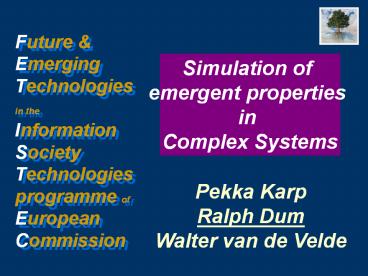Future PowerPoint PPT Presentation
1 / 11
Title: Future
1
Future Emerging Technologies in the
Information Society Technologies programme of
European Commission
Simulation of emergent properties in Complex
Systems
Pekka Karp Ralph Dum Walter van de Velde
2
Outline Towards an expansionist view on systems
science
- Drivers from science and engineering
- Beyond centralised top-down design and single
flow control - Inspired by natural and social systems
- Decentralised Design ? 1st call on Complex
systems in FET - Computational science and computational
engineering - Convergence of computation with science and
engineering - Simulation is central to scientific discovery and
systems engineering - Towards an expansionist view of systems science
- Need for a systematic understanding of emergence
- Focus on system structure rather than components
- ? This call on simulation of emergent
properties of CS
3
System design near Complexity barrier
Can we control the system without fully
controlling the components?
- Radical increase in number of system components
- Car industry 14 system layers 20.000 parameters
.. - Top-down design (divide and conquer) is
computationally hard - A posterior testing replaces a priori
verification - Components act autonomously in dynamic
environments - Need for decentralised control
- Components can be unpredictable and unreliable
4
Data in natural and social science Too much
and yet too little
Even if we understood the system components
How does the system work?
- Understand how components interact and form
dynamic networks sustaining system functionality - Causal relations in networks e.g. in biology
depend strongly on system topology ? network
causality - Incomplete data
- novel tools for probabilistic reasoning
5
Inspired by natural and social systems (1)
Societies
Many heterogeneous, autonomous interacting
parts
Large scale artificial systems
Life Eco-Systems
Decentralised approach to system science
- In natural and social systems, components achieve
collectively - Reliability/robustness
- Plasticity
- Scalability
6
Inspired by natural and social systems (2)
- Systems can organise in absence of central
control - Systems organise in complex hierarchic structures
A systematic approach to hierarchical structure
is missing
Expansionist approach to system science
Systematic studies of emergent system behaviour
via models that integrate descriptions on
various levels of aggregation and multiple
temporal/spatial scales
7
Convergence of computing with science and
engineering
Computing - Simulation
Simulation complements testing ,
prototyping, and experiment
Computational design
Opportunities for expansionist system approach
Computational science
- Simulation to bridge different levels of
description - Multi-scale simulation integrated for a whole
system view
8
Three pillars of this call
Multi-scale Modelling for a hierarchical system
Bayesian reasoning
Dynamical systems
Formal language
Simulation allows to connect different levels
of description
9
Objectives summarised
- Mathematical framework for hierarchical systems
Scalable computational modelling and inference
tools - Inference of system models from the dynamic laws
governing the interaction structure of components - Develop design strategies for aggregate behaviour
to obtain reliability and predictability in
presence of uncertainty or in absence of full
control at component level
10
Research Priorities
- Hierarchic systems
- How to describe systems acting on multiple
scales? - Formal languages for hierarchic model description
- Understanding of architecture and functionality
of networks - Dealing with incompleteness and uncertainty
- Tools for probabilistic modelling and reasoning
- Bayesian techniques, evolutionary techniques..
- Integrated modelling environments
- Integrate simulations on different levels/
scales (model embedding) - Integrate data acquisition and modelling
11
Administrative issues and information
- Submission by 21st September 2005 at 1700
- Evaluation session 24th 28th October 2005
- Start of projects early summer 2006
- Size of consortia typically 4-8 partners
- Funding typically 1.0MEuros - 2.5MEuros
- Duration 3 years
- 2nd European conference on CS, Paris, Nov. 14th
-18th - cordis.lu/ist/fet/co.htm complexityscience.org

